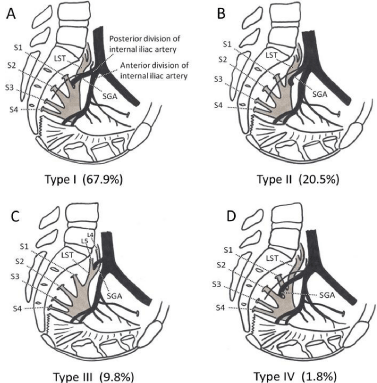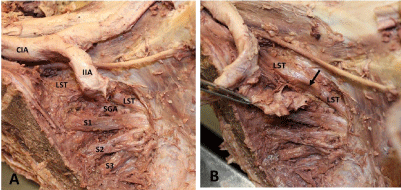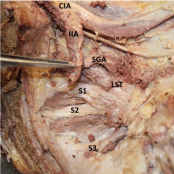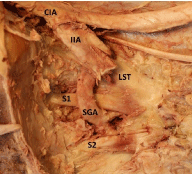
Research Article
Austin J Anat. 2015;2(1): 1030.
The Relationship between the Superior Gluteal Artery and Lumbosacral Plexus
Cook M*
Department of Integrative Biology and Physiology, University of Minnesota, USA
*Corresponding author: Cook M, Department of Integrative Biology and Physiology, University of Minnesota, 321 Church Street SE, Minneapolis, MN 55455, USA.
Received: January 22, 2015; Accepted: March 03, 2015 Published: March 05, 2015
Abstract
Background: The internal iliac artery has been shown to branch with great variability. As the superior gluteal artery leaves the pelvic cavity through the greater sciatic foramen it travels around the roots of the lumbosacral plexus, often compressing underlying nerves. Knowledge of the variability with which the superior gluteal artery passes around the roots of the lumbosacral plexus is clinically important. The information may help physicians better understand how the superior gluteal artery can compress roots of the lumbosacral plexus.
Methods: 112 adult human pelvic halves were procured from cadavers for this study.
Results: The Superior Gluteal Artery (SGA) was found to take four different pathways through the lumbosacral plexus. The most common path taken by the SGA was between the Lumbosacral Trunk (LST) and anterior ramus of spinal nerve S1. This occurred in 76 of the 112 specimens (67.9%). The second most common path taken by the SGA was lateral to (outside of) the LST. This occurred in 23 of the 112 specimens (20.5%). The third most common route taken by the SGA was between the L4 and L5 part of the LST. This occurred in 11 of the 112 specimens (9.8%). The least common course of the SGA was between the anterior rami of spinal nerves S1 and S2. This was observed in 2 of the 112 specimens (1.8%). In most cases, either the superior gluteal artery or posterior division of the internal iliac artery passes firmly over the surface of one of the nerve roots of the lumbosacral plexus.
Keywords: Superior gluteal artery; Lumbosacral plexus; Lumbosacral trunk
Abbreviations
SGA: Superior Gluteal Artery; LST: Lumbosacral Trunk
Introduction
The internal iliac artery supplies blood to the pelvic viscera, pelvic wall, perineum and gluteal region. It typically branches into anterior and posterior divisions, each giving rise to additional branches. The anterior division of the internal iliac artery commonly gives rise to umbilical, vesical, uterine, middle rectal, obturator, inferior gluteal and internal pudendal arteries. The posterior division commonly gives rise to iliolumbar, lateral sacral and superior gluteal arteries (Figure 1). There is significant variability in the branching of the internal iliac artery [1-7].

Figure 1: Branches of the Internal Iliac Artery. IIA: Internal Iliac Artery; AD:
Anterior Division of the internal iliac artery; PD: Posterior Division of the
internal iliac artery; ILA: Iliolumbar Artery; LSA: Lateral Sacral Artery; SGA:
Superior Gluteal Artery.
The Superior Gluteal Artery (SGA) is usually the largest branch off the posterior division of the internal iliac artery. Unlike the branches of the anterior division, it is not very mobile due to its route of exit through the posterolateral aspect of the pelvis. The SGA passes in close proximity to the roots of the lumbosacral plexus as it travels through the greater sciatic foramen.
Regardless of the branching pattern of the internal iliac artery, one thing remains fairly consistent; the SGA must leave the pelvis soon after branching off the internal iliac artery, and must pass around the subjacent lumbosacral plexus in order to do so. As the SGA leaves the pelvis through the greater sciatic foramen, it often passes tightly against the underlying nerves, having the greatest potential of the pelvic arteries to compress underlying nerve roots. Aneurysm of the SGA has been shown to produce foot drop and sciatica [8-10]. However, understanding the specific course of the SGA around the lumbosacral plexus is important in order to understand which parts of the lumbosacral plexus are most susceptible to compression by the SGA and how to treat the problem.
Many of the popular anatomical references describe and depict the SGA leaving the pelvis by passing between the Lumbosacral Trunk (LST) and anterior ramus of spinal nerve S1 [11-15]. One reference appears to show it passing between the L4 and L5 roots of the LST [16] and in others it is difficult to discern [17,18]. Grant’s Dissector, a guide commonly used in medical anatomy courses, describes the SGA as a branch that “usually passes between the LST and anterior ramus of spinal nerve S1.’ Yet there are no references in the literature for the variability in the course taken by the SGA around the lumbosacral plexus as it leaves the pelvis.
Understanding the variability with which the SGA passes by the lumbosacral plexus may help medical doctors locate this relatively large artery during surgical procedures and help explain how it can cause foot drop and sciatica. The information may even raise enough awareness of the potential of the SGA to affect the sciatic nerve function that it should be taken into consideration when deciding on a treatment for sciatic nerve compression. This study will describe four different pathways taken by the SGA around the lumbosacral plexus as it leaves the pelvis through the greater sciatic foramen.
Materials and Methods
112 formalin fixed adult human pelvic halves were procured from the Anatomy Bequest Program at the University of Minnesota. Specimens were collected during routine pelvic dissections during the medical anatomy course. The dissections were performed over a one week period of time. Of the 56 cadavers dissected, there were 23 males and 33 females. All of the cadavers were Caucasians from Minnesota (age range 54 – 101). A horizontal section through the abdomen at the fourth lumbar level was performed, followed by the division of the pelvis into two equal halves. The pelvic viscera were first divided with a scalpel, followed by sectioning of the pubic symphysis, sacrum/ coccyx and remaining lumbar vertebrae using a handsaw. All of the branches of the internal iliac artery were cleaned by removing surrounded connective tissue using common dissection techniques. The lumbosacral plexus was then cleaned with careful dissection. The branches of the internal iliac vein were removed during the dissections in order to clearly visualize the relationship of the SGA to the lumbosacral plexus. The age, sex, side and relationship of the SGA to the lumbosacral plexus were recorded for each hemipelvis.
Results
The SGA was found to take four different pathways through the lumbosacral plexus (Figure 2). The most common path taken by the SGA was between the LST and anterior ramus of spinal nerve S1 (type I). This occurred in 76 of the 112 specimens (67.9%). The posterior division of the internal iliac artery often compressed the underlying LST with this type (Figure 3). The second most common path taken by the SGA was lateral to (outside of) the LST (type II). This occurred in 23 of the 112 specimens (20.5%). With this type, the SGA was often seen traveling over the LST before passing its lateral border, outside of the plexus (Figure 4). The third most common route taken by the SGA was between the L4 and L5 part of the LST (type III). This occurred in 11 of the 112 specimens (9.8%). The SGA did not pass over the surface of a nerve root in this type due to its direct route between L4 and L5 roots (Figure 5). The least common course of the SGA was between the anterior rami of spinal nerve S1 and S2 (type IV). This was observed in 2 of the 112 specimens (1.8%). When the SGA passed between S1 and S2 roots (type IV), it passed firmly over the S1 nerve root (Figure 6). In 18 of the 56 cadavers, the type on one side of the pelvis was different than the other.

Figure 2: Drawings showing the variation in the course of the Superior
Gluteal Artery (SGA) with respect to the lumbosacral trunk and anterior rami
of spinal nerves S1-S4. A: The SGA travels between the Lumbosacral Trunk
(LST) and S1 nerve root (Type I). B: The SGA travels lateral to (outside) the
LST (Type II). C: The SGA travels between the L4 and L5 portions of the LST
(Type III). D: The SGA travels between the anterior rami of spinal nerves S1
and S2 (Type IV).

Figure 3: In this dissection of the left side of the pelvis, The Internal Iliac
Artery (IIA) is seen branching from the Common Iliac Artery (CIA) and
entering the pelvis. The posterior division of the IIA gives rise to the Superior
Gluteal Artery (SGA), which passes between the Lumbosacral Trunk (LST)
and anterior ramus of the S1 nerve root (S2). The anterior rami of the S2 and
S3 nerves roots are labeled for reference.
b: As the posterior division of the internal iliac artery is lifted away from the
Lumbosacral Trunk (LST) a visible impression is seen (arrow), indicative of
the close proximity of the artery to the underlying nerve root.

Figure 4: In this dissection of the left side of the pelvis, the Internal Iliac Artery
(IIA) is seen branching from the Common Iliac Artery (CIA) and entering the
pelvis. The Superior Gluteal Artery (SGA) travels over the lumbosacral trunk
LST for exiting along its lateral surface. The anterior rami of spinal nerves
S1-S3 are labeled for reference.

Figure 5: In this dissection of the left side of the pelvis, the Superior Gluteal
Artery (SGA) is seen leaving the pelvis by passing between the L4 and L5
roots of the Lumbosacral Trunk (LST). The Common Iliac Artery (CIA) and
anterior rami of S1 and S2 nerve roots are labeled for reference.

Figure 6: In this dissection of the left side of the pelvis, the Internal Iliac Artery
(IIA) is seen branching from the Common Iliac Artery (CIA) and entering the
pelvis. The Superior Gluteal Artery (SGA) travels closely over the surface
of the anterior ramus of spinal nerve S1 before passing out of the pelvis
between the anterior ramus of S1 and S2 spinal nerves. The Lumbosacral
Trunk (LST) is labeled for reference.
Discussion
The variability of the branching pattern of the internal iliac artery is well documented in the literature. The arrangement of the roots of the lumbosacral plexus is also well understood. However, this study is the first to focus on the relationship that the SGA has with the lumbosacral plexus as it leaves the pelvis. It demonstrates that the most common path taken by the SGA through the lumbosacral plexus is between the LST and anterior ramus of spinal nerve S1. This is the neurovascular relationship most often represented in anatomy atlases and textbooks. However, the SGA can also pass lateral to (outside of) the LST (20.5 %), between the L4 and L5 roots of the LST (9.8%) or between the anterior rami of spinal nerves S1 and S2 (1.8%). The path taken by the SGA through the roots of the lumbosacral plexus may help physicians identify an arterial source of sciatic nerve compression.
Conclusion
Most of the commonly used anatomical reference books depict the most common relationship of the SGA and lumbosacral plexus. However, this study demonstrates that the SGA takes other paths through the plexus with significant frequency (approximately 32%). Additional studies are underway to determine if other branches of the internal iliac artery, or internal iliac vein, pose additional concerns of pelvic nerve compression as they leave the pelvis.
References
- Braithwaite JL. Variations in origin of the parietal branches of the internal iliac artery. J Anat 1952; 86: 423-430.
- Yamaki KI, Saga T, Doi Y, Aida K, Yoshizuka M. A statistical study of the branching of the human iliac artery. Kurume Med J. 1998; 45: 333-340.
- Fatu C, Puisoru M, Fatu IC. Morphometry of the internal iliac artery in different ethnic groups. Ann Anat. 2006; 188: 541-546.
- Bleich AT, Rahn DD, Wieslander CK, Wai CY, Roshanravan SM, Corton MM. Posterior division of the internal iliac artery: Anatomic variations and clinical applications. Am J Obstet Gynecol. 2007; 197: 658.e1-5.
- Bilhim T, Casal D, Furado A, Pais D, O’Neill JEG, Pisco JM. Branching patterns of the male internal iliac artery: imaging findings. Surg Radiol Anat. 2011; 33: 151-159.
- Bergman RA, Afifi AK, Ryosuke M: Internal iliac artery. Illustrated Encyclopedia of Human Anatomic Variation. Opus II. Cardiovascular System. Arteries. Pelvis. 2013.
- Havaldar PP, Sameen T, Angadi AV, Saheb SH. Study of posterior division of internal iliac artery. Int J Anat Res. 2014; 2: 375-379.
- Proschek R, Fowles JV, Bruneau L. A case of post-traumatic false aneurysm of the superior gluteal artery with compression of the sciatic nerve. Can J Surg. 1983; 26: 554-555.
- Zafarghandi MR, Akhlaghi H, Shojaiefard A, Farshidfar F. Sciatic nerve compression resulting from posttraumatic pseudoaneurysm of the superior gluteal artery: A case report and literature review. J Trauma. 2009; 66: 1731-1734.
- Ge PS, Ng G, Ishaque BM, Gelabert H, de Virgilio C. Iatrogenic pseudoaneurysm of the superior gluteal artery presenting as pelvic mass with foot drop and sciatica: Case report and review of literature. Vasc Endovasc Surg. 2010; 44: 64-68.
- Drake RL, Vogl AW, Mitchell AWM, Tibbitts RM, Richardson PE. Gray’s Atlas of Anatomy. Churchill Livingstone Elsevier. 2008.
- Tank PW. Grant’s Dissector. 14th edn. Lippincott Williams & Wilkins. 2009: 129-145.
- Netter FH. Atlas of Human Anatomy. 5th edn. W.B. Saunders. 2010: 382.
- Agur AMR, Dalley AF. Grant’s Atlas of Anatomy. 13th edn. Lippincott Williams & Wilkins. 2013: 216-246.
- Moore KL, Dalley AF, Agur AMR. Moore Clinically Oriented Anatomy. 7th edn. Lippincott Williams & Wilkins. 2014: 354.
- Hollinshead WH, Rosse C. Textbook of Anatomy. 4th edn. Harper and Row. 1985: 750.
- Gilroy AM, MacPherson BR, Ross LM. Atlas of Anatomy. Thieme Medical Publishers. 2008: 208.
- Clemente CD. Anatomy: A Regional Atlas of the Human Body. 6th edn. Lippincott Williams & Wilkins. 2011: 323-370.